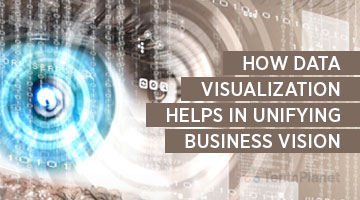How Data Visualization helps in Unifying Business Vision

I. Introduction
Data visualization is the graphical representation of information and data. By using visual elements like charts, graphs, and maps, data visualization tools provide an accessible way to see and understand trends, outliers, and patterns in data. In the world of Big Data, data visualization tools and technologies are essential to analyze massive amounts of information and make data-driven decisions.
As the volume of data continues to increase, more vendors and communities are developing tools to create clear and impactful graphics for use in presentations and applications. Although not exhaustive, the below table list some popular Visualization tools ;
OpenSource
Commercial Tools
R (ggplot2) Pentaho Enterprise D3 Spotfire Gnuplot Qlikview Pentaho Community Tableau Weave
II. Advantages of Data Visualization
Visualization allows people to portray data in a more compelling way than tables of data and in a way that can be understood on an intuitive, precognitive level. In addition, analysts and data scientists can use visualization to interact with and explore data. Following is an example of how the visualization helps in obtaining meaningful insights than the actual tabular data;
Month | Product A | Product B |
| Jan | 10 | 20 |
| Feb | 29 | 17 |
| Mar | 22 | 15 |
| Apr | 30 | 17 |
| May | 19 | 18 |
| Jun | 23 | 28 |
| July | 23 | 18 |
| Aug | 17 | 12 |
Consider the table given above, It is more difficult to observe key insights when data is in tables instead of in charts. To underscore this it is best to create a visual representation out of the tabular data, such as a chart, graph, or other data visualization. Also, sharing the information it in a table draws less attention to it and makes it more difficult for people to digest.
The way one chooses to organize the visual in terms of the colour scheme, labels, and sequence of information also influences how the viewer processes the information and what he perceives as the key message from the chart.

From the above visualization, it can be noted that the Product A has better performance in terms of sales when compared with Product B. Understanding the same information in tables looks complicated and easily distractive.
When you think of data visualization, your first thought probably immediately goes to simple bar graphs or pie charts. While these may be an integral part of visualizing data and a common baseline for many data graphics, the right visualization must be paired with the right set of information. There’s a whole selection of visualization methods to present data in effective and interesting ways. Some of them are;
General Types of Visuals:
- Charts
- Tables
- Graphs
- Maps
- Infographics
- Dashboards
Other Types of Visuals:
- Area Chart
- Bar Chart
- Box-and-whisker Plots
- Bubble Cloud
- Bullet Graph
- Dot Distribution Map
- Gantt Chart
- Heat Map
- Histogram
- Network
- Scatter Plot
- Treemap
- Word Cloud and many others
Some of the advantages of Data Visualization and how it affects the decision making process;
- Prompt Action – Automated Data Visualization tools can manipulate data quickly and effectively. Different teams across the business can present their data in different forms and levels of detail, depending on their specific objectives and target audience.
- Constructive Communication – Decision makers can easily interpret wide and varying data sources through interactive elements and new visualizations such as heat maps and fever charts. Rich but meaningful graphics help engage and inform busy executives and business partners on problems and pending initiatives.
- Unifying Business Vision – Data Visualization can help professionals across the business, from sales and marketing to IT, acquire a shared point of view on important trends and issues.
- Advanced Visualization (Machine Learning) – The hype around machine learning is all to real. Not are only are the big companies like Amazon, Google are implementing Machine Learning, several, smaller companies are already in the fray to use ML and get advance Insights.
III. Conclusion
As the era of big data kicks in, visualization is an increasingly key tool to make sense of the trillions of rows of data generated every day. Data visualization helps to tell stories by curating data into a form easier to understand, highlighting the trends and outliers. A good visualization tells a story, removing the noise from data and highlighting the useful information.
